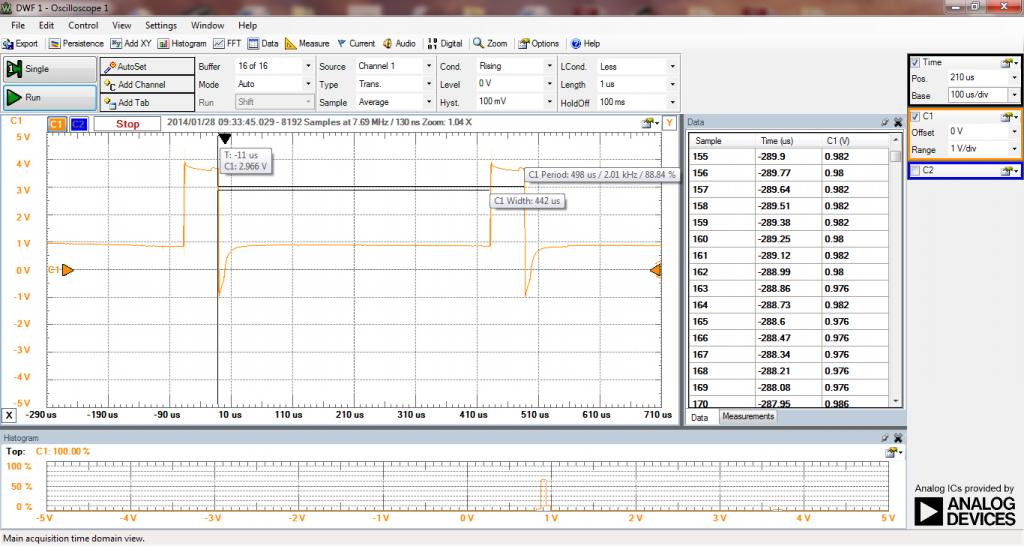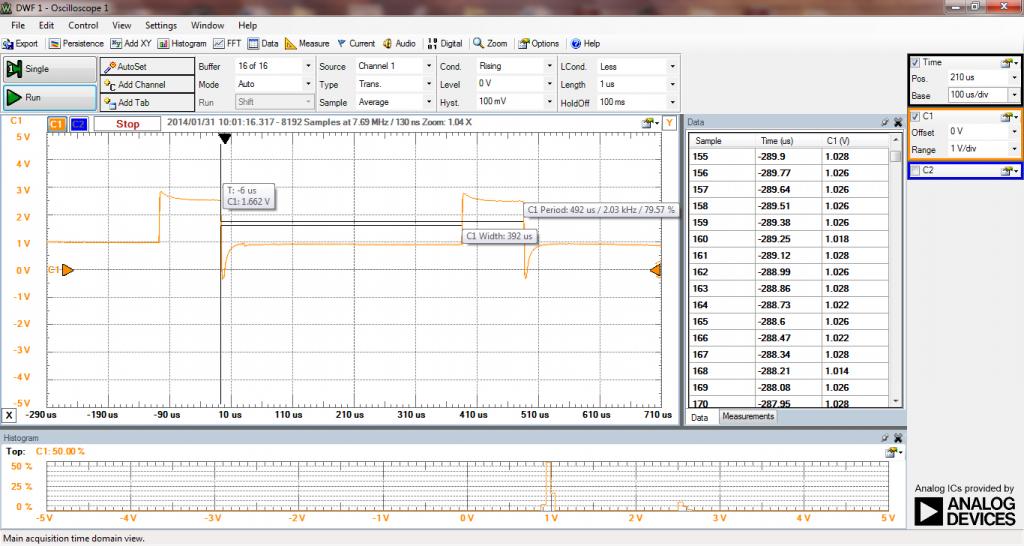Help Understanding transistor output (TIP120/TIP31), why doesnt it allow max V?
Hi everyone, Ive been working on trying to figure out why I cant control one of those tiny quadchopter motors as well as the quadchopter can. Most of this is new to me, so Ive been learning a lot and making some progress, but I still cant figure out why its only every partially on or partially closed.
You can see in this picture the single that the quadchopter is receiving from the actual board.

Note how the voltage doesnt go below ~1V for the off position, but it does go fully open ~3.7V (single cell lipo battery) (Don't worry about the duty of the wave, I can control that.)
Now when Im using a TIP120 it only goes to around 2.5V fully on. It should go to ~3.7V.

So Im wondering:
1- Am I using the wrong transistor/MOSFET
2- Am I hooking it up wrong? (see below)
3- How do I create the same wave that the quadchopters board is natively doing?
My set-up following this layout (http://bildr.org/blog/wp-content/uploads/2011/03/tip120-solenoid.png):

You can see in this picture the single that the quadchopter is receiving from the actual board.

Note how the voltage doesnt go below ~1V for the off position, but it does go fully open ~3.7V (single cell lipo battery) (Don't worry about the duty of the wave, I can control that.)
Now when Im using a TIP120 it only goes to around 2.5V fully on. It should go to ~3.7V.

So Im wondering:
1- Am I using the wrong transistor/MOSFET
2- Am I hooking it up wrong? (see below)
3- How do I create the same wave that the quadchopters board is natively doing?
My set-up following this layout (http://bildr.org/blog/wp-content/uploads/2011/03/tip120-solenoid.png):



Comments
I agree with verything Peter said about the crappy TIP-120.
Just not suitable for these applications. The TIP120 has to much voltage drop.
A much better part is the IRF3708 MOSFET.
This can switch quite high currents without a heatsink. Easily 15A when driven with a Prop.
Everyone should have the IRF3708 in their bag of tricks.
Duane J
Hi Peter, thanks for the info. So the Vce(sat) is the amount of voltage that's used to keep the gate "open"? I'm a little bit confused on how you got the 1.4V for the Vce(sat). I think the data sheet says that at 12ma at the base it's 2.0V.
Anyhow, I tried a ZVN2110A MOSFET that I had in a kit, but the results were worst than before.
I thought that the max voltage was 60V, but it appears to be only 2.4V?
Do you know of an example MOSFET that would work for driving ~2A at 3.7V so that I know what I'm looking for?
I was also wondering what you meant about the little bit of knowledge, did you mean that the example they gave was incorrect? That you shouldn't use a TIP120 for driving a motor? I know that I'm dangerous with what I know right now, but I hope not to be.
Thanks for your help!
Thanks Duane, I was writting Peter back and didn't see this before I made my post. I'll take a look at the IRF3708.
Got it TIP-120 == crappy
Either use MOSfets, or provide a higher voltage power source.
Arduino loves to give examples using the TIP120 to the uninformed <sigh>.
Using the IRF3708 as a starting point I found the FDU3N40TU that I think will work for me. If I'm reading the data sheet correctly, it will do 2A continuously. The rds on is 3.4 ohms compared to 12m ohms that the 3708. I don't know how much that matters. Any advice?
http://www.mouser.com/ProductDetail/Fairchild-Semiconductor/FDU3N40TU/?qs=sGAEpiMZZMshyDBzk1%2fWiw3ktwnhg7wCL%2fcMbgLH3Qo%3d
As with any device, it's only crappy when used in an incompatable application. Otherwise, the TIP-120 is a typical darlington that's had a long and useful life.
Hey Dave, thanks. I should have specified as being a poor choice for a motor controller.
Dave
The RDS(on) is the important specification. Then the required gate voltage and other things.
Yes the IRF3708 has a 62A current rating but we don't really care about that.
The IRF3708 has an RDS(on) of about 15mΩ.
This is important because if you want to switch 2A of current:
ID * RDS(on) = VDS(on)
2A * .015Ω = 0.03V
ID2 * RDS(on) = PD Power Dissipation
2A2 * .015Ω = 0.06W Really low so it won't get hot.
Clearly no heat sink would be required.
However with the ZVN2110A which has an RDS(on) of 4Ω:
ID * RDS(on) = VDS(on)
2A * 4Ω = 8V
ID2 * RDS(on) = PD Power Dissipation
2A2 * 4Ω = 16W This will get HOT.
Even a heat sink would not help this.
The FDU3N40TU is only slightly better with an RDS(on) of 3.2Ω:
ID * RDS(on) = VDS(on)
2A * 3.2Ω = 6.4V
ID2 * RDS(on) = PD Power Dissipation
2A2 * 3.2Ω = 12.8W Not quite as HOT but still will kill it even at 2A.
Take a look at the lists of parts on my web page.
Many of the parts people have used on this forum are listed there.
Click the part# on the left for the spec sheet.
These have generally been sorted by VG.
On the right are graphs I have personally measured.
Anyway:
First look at the RDS(on) to calculate the VDS(on) voltage drop and PD power dissipation.
If either is to high, choose a part with lower RDS(on).
Then go on to VDSS and VGS suitable for your application.
BTW, why do they make all those weak parts. Because there are many applications where high currents are not needed.
Even the high current parts will need a heatsink when switching very high currents.
And there are lots of other parameters to consider, but for now stick with RDS(on).
Duane J
This is great! and your website is such a great resource!
So, to continue, the voltage threshold (Vth) is the amount of voltage that needs to be exceeded by the gate voltage (Vgs) in order for current to flow through the MOSFET. In the case of the IRF3708, the MOSFET allows current to flow once the Vth of 2.0V is applied to the gate. Applying more voltage to the gate continues to decreases the resistance of the gate.
So, if I have a NTE2395 with a Vgs min of 2.0 and a max of 4.0, I would need to apply between 2 to 4v for it allow current to flow through?
http://www.nteinc.com/specs/2300to2399/pdf/nte2395.pdf
Am I following this correctly? Thank you very much for your help.
Dave
Vth is a guide as to when it just starts to conduct, but it's a useless figure IMO, check the Rds(on) as Duane mentioned and in fact just consider the device list he referred to rather than trying to work this out yourself at present.
The Stamp, 5V, is able to effectively drive what are called "Logic Level" MOSFETs. There will clearly be an RDS(on) specified, usually; for 4.5V or so.
The Prop, 3.3V, is able to effectively drive what are called "Sub Logic Level" MOSFETs. There will clearly be an RDS(on) specified, usually; for 2.7V or so. In this case 2.8V for the IRF3708. Often the RDS(on) will be lower if the gate voltage is higher.
BTW, there are specialized MOSFETs that can operate on even lower gate voltages. They just keep getting better. Yea!
I think so.
But seriously, Bite The Bullet. Order say 10 or so of the IRF3708 from DigiKey or Mouser, about $14. These, at a minimum, are a "Required" component in the parts stash.
There are a few others I like with a smaller TO-251 or IPAK package:
RFD14N05L Not as high a current but a much smaller package. (Ok, there is no RDS(on) @ 2.7V entry in the spec but I know it works well on the Prop as I measured them, (can't use it in a commercial application running on 3.3V). Pretty cheap at $16 for 25 of them.
Duane J
it below the minimum Vth. Its absolutely irrelevant to the device being ON. Crudely speaking a device is on when
the gate is above the plateau voltage (seen the graphs in datasheets of Vgs against gate charge). However
most graphs in datasheets are "typical values" so you cannot rely on them except to get a feel for the parameters,
you always go back to the Rds(on) spec to see what Vgs is needed to guarantee behaviour.
Duane, thank you especially for laying everything out so clearly.
Dave
I guess what I'm saying is that in the context of this forum we are normally discussing switching apps and everyone seems to see and quote the Vth figure and expect to switch many amps at that voltage, so it's a very misleading figure for switching. Now Rds(on) is much better but also like buying a house you can't just look at the beuatiful gate or the well equipped kitchen, you have to see it as a whole (or you might end up with a hole).
1. BS108 with guaranteed RDS(ON) of VGS at 2.8V & 2.0V.
2. ZVNL120A with guaranteed RDS(ON) of VGS at 3.0V.
3. And of course the venerable 2N7000. Works well with the Prop although the spec doesn't guarantee it but I have measured them.
And many others for one reason or another.
I don't invest in gold, I invest in silicon.
In general, the snubber diode is fairly uncritical. Just use a silicon rectifier diode with a peak current rating equal to the maximum current flowing through the coils of the relay or small motor if you don't switch to rapidly. Any of the standard 1A 1N400x series usually work nicely, they have a pretty high peak current rating.
(If fast switching is needed get back to us.)
Oh, and you don't want to use a Schottky diode.
Thanks, just trying to help!
Duane J
Poor choice for a 5 volt motor controller, but not so bad for 24 or 36 or 48 volt motor controller. The 2 volt drop remains constant and devices are rated to go up to 100 VDC.